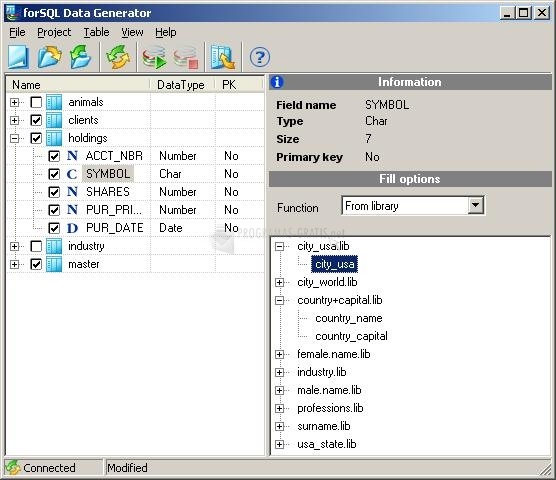

- Sql server data generator generator#
- Sql server data generator manual#
- Sql server data generator full#
- Sql server data generator software#
- Sql server data generator series#
Sql server data generator full#
We could just generate everything right now but that would make for a very short blog post and not fully demonstrate the full power of the tool. We than land up on a screen consisting of three panels allowing us to configure the data generation. Project setup is a piece of cake just point it at a server and choose a database: Yep, 91,000 customers with 830,000 orders containing 2,155,000 order details across 77,000 products managed by 9,000 employees. Lightweights! Let’s turn this up by, oh, a factor of one thousand. Out of the box, Northwind gives you 91 customers with 830 orders containing 2,155 order details across 77 products managed by 9 employees. Why these four? Because they’re very atypical of many apps, they span a good range of both SQL data types and logical data values and there’s a bunch of relational integrity going on to make things interesting. In particular, I want to focus on these four tables:
Sql server data generator generator#
Moving on, we’re going to use SQL Data Generator (normally a $295 spend), to push a whole heap of data into your classic Northwind database. They’re entirely unobtrusive in the development process they work with you rather than asking you to change the things you’re already comfortable with.They take traditionally laborious tasks and automate them into near instantaneous processes.They’re extremely intuitive and easy to get up and running with fast.There’s a pattern with the Red Gate tools and I’m not just saying this because of the Friends of Red Gate thing: Just don’t do this, ok? The SQL Data Generator solution It could also well mean that your test or development environments are beginning to create dependencies on a production state (i.e.

Pulling a copy of production data: Don’t ever, ever, ever do this! Just don’t! Not only is there a huge confidentiality risk, there’s also something seriously wrong with the underlying app lifecycle if you’re able to readily pull production data backups into a test environment. If you’re looping through and inserting a million “John Smith” records it’s not going to look right during testing and chances are the black magic within SQL Server’s indexing and query optimisation is not going to behave the way it would with real data. Secondly, it’s not reflective of real data. Have a half dozen tables with multiple columns and relational integrity considerations and there goes a significant amount of time. Hand-crafted scripts: So why not just write some scripts to insert the required number of records? You’ve got two problems with this: Firstly, anything more than a very basic script becomes tedious. You’re inevitably going to either blow huge amounts of time or end up with an insufficient set of data to test against.

Sql server data generator manual#
Manual creation: Using the app to organically create test data is just plain tedious. Here are some popular approaches which are ultimately all pretty flawed: Thing is though, the way some folks deal with them is rather problematic. The issues above are not new, in fact they’re very well trodden paths. A customer management app, for example, is going to be very hard to test without a good set of customer records. Many of the functions they need to perform in order to fully experience the product are dependent on the presence of data.
Sql server data generator software#
One of the primary ideas of a test cycle is that it allows the app owner to experience what the software will be like once it rolls out. “It never did that under development or test.” A handful of records in your test environment versus a few million in production will do that.Īnother issue is usability. It’s a common scene for a developer to begin scratching his head when faced with the lethargic performance of an application which has spent some time accruing transactional data. Software has a funny habit of behaving differently once it starts dealing with decent volumes of data. So what’s the problem? Well, there’s a couple of discrete challenges when suitable test data is not available, one of them being performance. In fact it’s almost magical when you see it in action over your own data schema. And then there’s Red Gate’s SQL Data Generator, which is none of these. There are a whole bunch of counter-techniques for the empty database problem ranging from the tedious to the impractical to the downright ridiculous. The problem is simply this: without data in the test environment which is representative of what you’ll end up with in the production environment, it’s very difficult to properly simulate the way the app will behave after it rolls out.
Sql server data generator series#
A series of discussions last week got me around to talking about the right way to test a system against a realistic set of data.


 0 kommentar(er)
0 kommentar(er)
